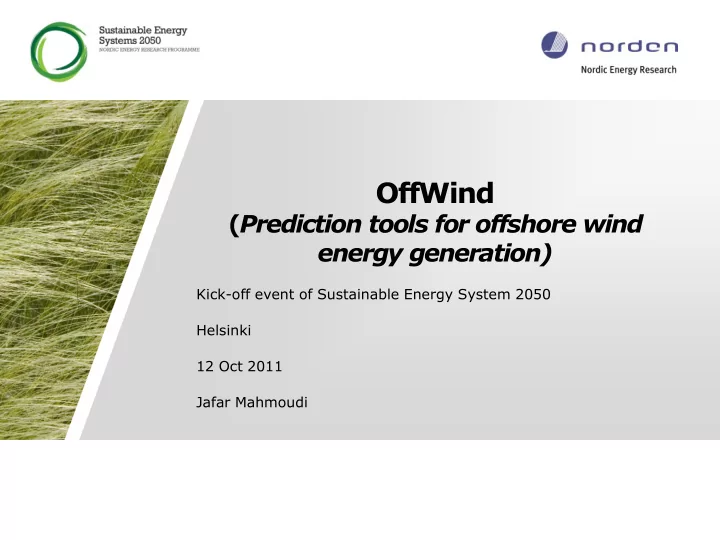

OffWind ( Prediction tools for offshore wind energy generation) Kick-off event of Sustainable Energy System 2050 Helsinki 12 Oct 2011 Jafar Mahmoudi
Challenges Atmospheric modelling External Data Local ARPS Global Global Regional Models Models Obs. Models 100m-4 km 16-100 km 1-12 km WRF 9 km WRF 3 km WRF ARPS 75m 1 km 2 Projects
Challanges Grid independence study Wind direction : 270 degrees Wind speed: 10 m/s at hub height (75m asl)
Challenges multi-scale model simulations (Bechmann et al 2007) Will LES improve the flow statistics?
Challnges: Mesoscale/ Micro scale coupling Challanges Wind Atlas and Wind Mapping → Preliminary assessment of regional or site wind climate Virtual Wind Data Series → Annual Variability, Long Term correlation, coupling with Microscale Meso/Micro Coupling → Preliminary WF Micrositing and AEP Estimates Meso/CFD Coupling → First assessment of specific or hazardous wind conditions (Site Assessment) Annual Variability and Wind Indexes Quantification of extreme events → Icing and cold climates, Hot climates, Extreme winds
Challenges Wind-wave interactions - LES model Mean wind profile, turbulence variances and vertical momentum flux depends on the state of the wave field.
Objectives • The primary objective of the project is to develop tools for design and operation assessment and forecasting for offshore wind farms. • The tools will lead to optimal localization of a wind farm and more importantly how to locate future wind farms with respect to each other within the same wind energy cluster. • The tools will also lead to a more cost efficient and safer wind farm operation as the operation parameters can be more accurately predicted and thus optimize the total wind power generation from a wind energy cluster as well as reduce the probability of wind turbine failure under severe weather conditions.
Selected secondary objectives: • Assess existing tools with respect to wind flow, meteorology and grid interconnection (MetOcean-CFD codes, meso-/microscale codes, CFD/LES, WRF and PALM) • Improve offshore meso-/microscale prediction methodologies • Improve mesoscale CFD numerical models for offshore wind predictions using MetOcean Models/ data • configuration wind- Wave interactions, wake evolutions • Improve existing optimization tool for offshore wind turbine specification versus wind farm • Develop methods for online nowcasting of available farm power (1-60 min)
Offwind Wps • WP 1: Numerical modeling for wind turbine and wind farm performance predictions • WP 2 Experiments and model validation and calibration • WP3 Fully coupled wind-wave interaction model • WP 4 Nowcasting of available farm power based on data driven modelling • WP 5 Database
Project Overview Organization Country Main partners Participate IRIS (Research center) Norway Wp1, Wp2, Wp3, Wp5 SINTEF (Research Norway Wp1, Wp3 Wp4, Wp5 center) Statoil (Industry) Norway Wp5 Wp2 Aalborg (University) Denmark Wp4 Wp5 Vattenfall (Industry) Denmark Wp3, wp5 Wp1, Wp2 Megajoule Portugal Wp3 Wp3 Mälardalen university Sweden Wp1, Wp3 Wp5 FuE-Zentrum FH Kiel Germany Wp5 Wp2 GmbH Design Builder UK Wp1 Wp3
Summary /Goal • This is a project proposal aiming at the development of computational tools for the prediction of the location and energy yield of offshore wind farms depending on the weather situation (condition of the ocean and atmosphere) and the presence of other wind farms (design and operation). • Dynamically consistent coupling between meso- and microscale models • MetOcean-CFD modelling approach • Wind Farm and Wind Farm Cluster Characterization • Fully functional prototype database
Recommend
More recommend